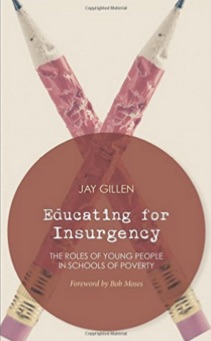Educating for Insurgency: The Roles of Young People in Schools of Poverty
Reviewed by Rosalie Dance
September 1, 2015
By Jay Gillen. AK Press, 2014. 178 pages. $15.95/paperback; $10.99/eBook.
Buy on FJ Amazon StoreA forward by civil rights leader Bob Moses gives Educating for Insurgency a powerful start. Moses worked on voter registration and started Freedom Schools in Mississippi in the 1960s as a member of the Student Nonviolent Coordinating Committee (SNCC). Recognizing that knowledge of mathematics and confidence in using it serve to help people gain control over their own destiny, he used his 1982 MacArthur Fellowship to found the Algebra Project. It is now a nationwide program to provide peer and near-peer mathematics teaching, using contexts of interest and concern to young African Americans, and implementing those concerns through social action. Now supported by the National Science Foundation, the Algebra Project is Moses’s ongoing work toward a just society.
Jay Gillen, author of Educating for Insurgency and a public high school mathematics teacher in Baltimore, has worked with the Baltimore Algebra Project (BAP) for 20 years. He offers this book as a “long-term radical solution to the problem of education in America.” The problem under his lens: many good teachers in schools of poverty are unable to meet all of their students’ needs (often because of the demands of authorities) and unable to meet the demands of authorities (often because of their students’ needs).
Educating for Insurgency is, Gillen says, in some sense a case study of the Baltimore Algebra Project. This project, and others as well, are generally run by young people. Gillen teaches in an “algebra project classroom” and works with college students who experienced the Algebra Project in high school and now organize BAP’s high school tutoring programs themselves and co-teach in algebra project classrooms.
Knowledge of mathematics opens doors to both economic and social opportunities. Mathematical tools and skills are required for many professions and trades in our economy; mathematical knowledge commands respect in our society. But the Algebra Project teaches more than the mathematics. It enables students to use their political power. Gillen helps the reader understand the circumstances of American youth in poverty and thus why use of their political power is critical for them, for those who follow them, and for the health of our society.
Gillen brings to bear on this the spirit of Ella Baker, the spiritual values and philosophical writing of Vincent Harding, Kenneth Burke’s philosophy, the works of Shakespeare and of Ralph Ellison, and the history of the quest for equality in America. He advocates for students to be central actors in their own story, to understand the root causes of their circumstances, to confront a system that does not meet their needs, and to devise means by which they can be instrumental in the changes they want to see. He argues that doing mathematics is a means of constructing a space in which to nurture these abilities and intentions.
America’s quest for racial equality, from the nineteenth-century Underground Railroad to the Civil Rights Movement to the Algebra Project, has significant moments both well-known and not so well-known. Who is not aware of the landmark 1954 U.S. Supreme Court decision Brown v. Board of Education of Topeka? It was a great victory for democracy. But who remembers the 1973 decision San Antonio Independent School District v. Rodriguez? In that case, the Supreme Court decided that the U.S. Constitution does not protect education as a fundamental right. More explicitly, it decided that a school financing system based on local property taxes was not a violation of the Fourteenth Amendment’s equal protection clause. Any schooling arrangement satisfies the law, provided there is no de jure separation by race or economic status. San Antonio v. Rodriguez has curtailed the effectiveness of Brown v. Board. American students with black or brown skin are more likely now to attend a segregated school than was the case in the 1960s. Separateness itself is not necessarily the problem, but since quality separate-but-equal schooling in areas of high poverty has had few exemplars, discussion of this is valid and necessary.
Gillen writes, “the action we seek must take no delight in the waste of anybody’s children, nor refuse consciousness of tragedy or history”; we must heed “the desires and actions of young people in poverty, so that we and they may act more gracefully.”
Young people of the Baltimore Algebra Project have been a strong voice for their own rights and well-being and that of their peers. Their work in their mathematical “crawl space” infuses in them a sense of agency and confidence to act, so when uprisings occurred in Ferguson, New York, and Baltimore recently, they were ready. They led peaceful youth demonstrations against police brutality, unreasonable bail, and designation of funds for a youth prison instead of education. With a coalition of other groups, they made their voices heard on the Maryland governor’s decision to cut funding for schools and decisions to close neighborhood schools that will result in small children having to walk long distances to a different school. They bring communities together to help them recognize their own agency and find their own voices. They have developed a Students Bill of Rights that, if implemented, will radically change the culture of their schools.
Respect for the beauty and power of mathematics is the basis of commitment to leading young people to knowledge and the confidence to use mathematics. But a broader empowerment of the students is key, both to the success of the individual and to evolution of our society along a path toward justice.
If you have a concern for education, a concern for social justice, or a concern for civil rights, read this important new book by a teacher on the frontlines.




Comments on Friendsjournal.org may be used in the Forum of the print magazine and may be edited for length and clarity.